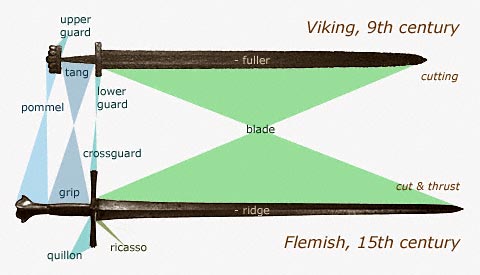
The swords of medieval Europe (approximately 500 to 1500 AD) evolved from steel Celtic swords, which in turn arose from a tradition of straight, double-edged swords which began with bronze swords as early as 1,500 BC. At the opening of the Middle Ages these swords tended to have blades just under a yard in length with a grip designed to accommodate a single hand; the other hand being concerned with the grip of a shield. Essentially all of the earliest medieval swords and many throughout the period were designed to cut, having surprisingly thin blades, especially towards the tip, which was often rounded. By the close of the Middle Ages, swords increasingly are stouter and more sharply pointed, being optimized for the thrust, the cut having been rendered less effective by improvements in armour. Similarly, with these armour improvements, the shield became redundant and swords with hilts effectively accommodating both hands make their appearance and grow in popularity.
The development of a amazingly wide diversity of hilt forms characterizes the European Renaissance, but in the Age of Enlightenment, the role of the sword as a personal weapon in most of Europe ends with the nasty foppish decadence of the small sword.
|
|
|
|
|
|
|
|
|
|
|
|
Copyright © 1997, 1998, 1999, 2000, 2001 by Lee A. Jones - please click to view copyright information and use permissions along with general caveats concerning using this site.